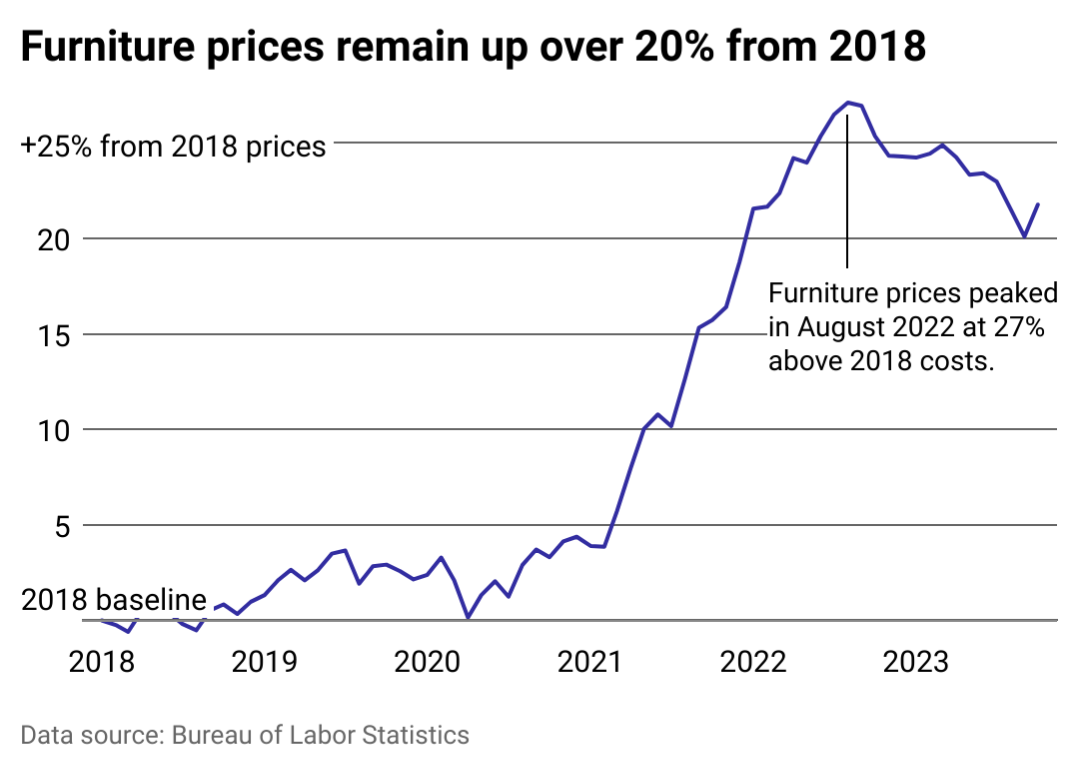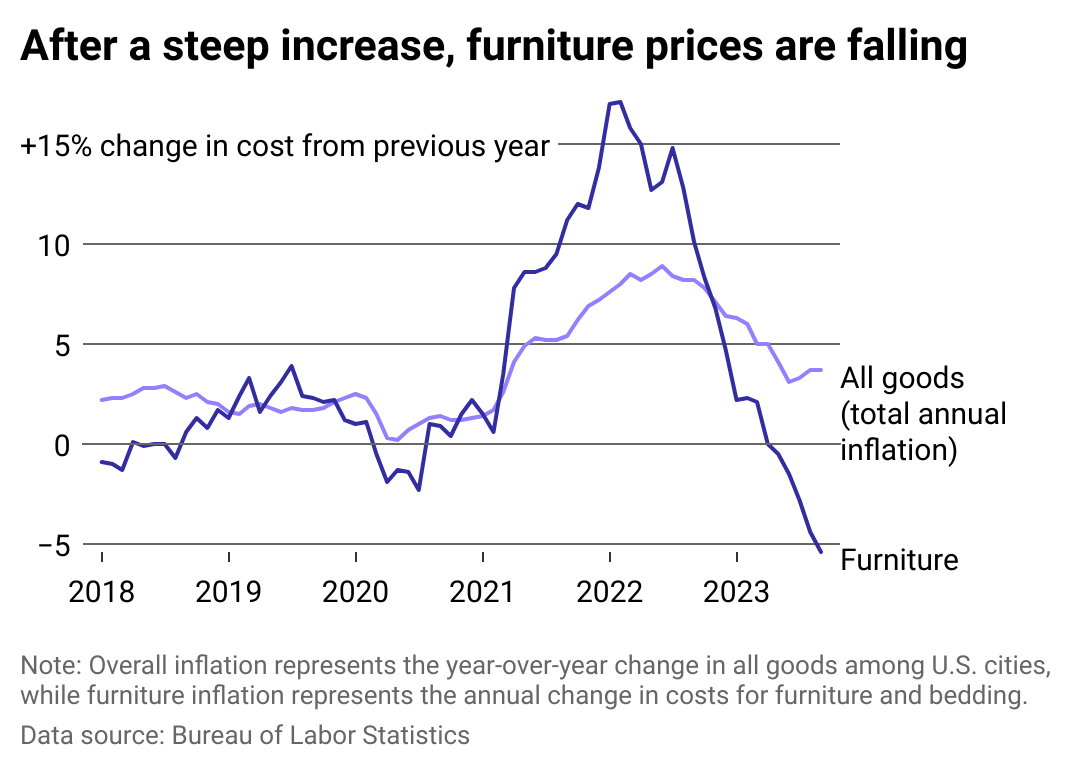After skyrocketing price increases over the past few years, furniture retailers are seeing a pandemic recovery slump amid ongoing inflation. Lazzoni Modern Furniture analyzed Bureau of Labor Statistics data to see what’s behind the fall.
According to the Department of Labor, market inflation rose to 5.3% in the 12 months leading up to August 2021 — it was a huge leap, considering inflation spikes had averaged around 1.7% over the prior 10 years. The pandemic wrought massive shipping and supply issues, creating supply chain disruptions. The expensive costs that manufacturers and sellers had to cover due to these supply chain disruptions—combined with the profit loss they needed to make up for—led to increased prices of goods and services, fueling high inflation.
Recommended Videos
A McKinsey & Company survey found that, by the end of 2021, most companies experiencing supply chain challenges had increased their inventories, meaning businesses spent more to stock up.
Economic challenges resulting from the pandemic heavily impacted furniture prices. Since 2019, furniture prices have seen massive changes: Prices jumped significantly in the 12 months ending October 2021 as the world grappled with the COVID-19 outbreak (12%) and, by August 2022, had outpaced the growth rate of market inflation, according to an analysis of year-to-year BLS data.
Black Men Sundays talks about building generational wealth. Check out every episode in the media player below:
However, as the U.S. economy entered recovery in 2023, consumer spending slowed while housing prices soared, which caused a ripple effect on the housing market. Subsequently, furniture retailers experienced drops in revenue, leading companies to slash product prices to make sales.
Even as the pandemic-induced inflation has cooled, sticker shock often plagues consumers who still remember pre-pandemic prices. That’s because prices tend to be “downwardly rigid,” Mike Konczal, Roosevelt Institute’s director of macroeconomic analysis, explained to Vox, meaning companies that raise their prices don’t usually lower them again.

Lazzoni Modern Furniture
Furniture prices are down but remain well above 2018-2020 prices
Despite ongoing inflation and declining furniture prices, they are still above where they were between 2018 and 2020.
At first, furniture costs rose along with inflation, like everything else during the onset of the pandemic. In 2020, consumers spent more time devoted to improving their living spaces as people hunkered down at home during the peak of the COVID-19 outbreak, which had an especially major impact on the housing market.
According to data from Comscore, a market metrics firm, 74.2 million U.S. consumers completed a home remodel within the 12 months prior to August 2020—an almost 20% increase in home remodeling activity compared to the same period in 2019. The outsized activity in the housing market led to astronomical spikes in home-related prices.
"With an increased focus on the home due to the pandemic, home prices rising to the highest on record (nearly 20% year-over-year), and materials prices in some cases 400% higher or more than their pre-pandemic levels, the major growth in total consumer spending on home improvement should not come as a surprise," Mischa Fisher, chief economist at Angi, a home services company, wrote in its 2021 State of Home Spending report.
Furniture costs saw increases as well. Month-to-month prices for household furnishings rose 1.6% in January 2022. Over the same period, furniture and bedding rose 2.4% month over month.
Soon, home and furniture costs began to match the pace of overall inflation. In August 2022, furniture costs peaked at 27% above 2018 prices. A broader look at market rates at the time shows the 12-month increase for furniture costs was 12.8% compared to the inflation rate of 8.3%, according to the Department of Labor. This meant the annual rate of furniture prices had surpassed the annual growth rate of the market's overall inflation.

Lazzoni Modern Furniture
In 2023, annual furniture prices saw the fastest drop in 5 years
At one point, furniture price changes had beaten the inflation rate of all goods. However, furniture prices have steadily trended downward at the close of 2023. Severe inflation has slowed as the U.S. economy shifted into recovery mode. In June 2023, the annual inflation rate went down to 3.2%, a slower pace of change than the peak 12 months prior of 9.1%.
Big company retailers reported growing sales thanks to increased prices on consumer goods. Still, customers were becoming more selective in their purchases, likely due to recalibrating their spending habits as they recovered from the effects of the pandemic.
This slowdown was apparent in the home improvement sector. Housing costs are at their highest in four decades, according to CNN. Mortgage rates in the U.S. reached a record high of 7% in summer 2023, a phenomenon brought on by various factors, including the Federal Reserve's continued increase of interest rates to avoid a pandemic-era recession (the agency paused its interest rate hikes in October 2023—keeping it at 5.4% until the end of the year).
High housing market prices have put off consumer spending and, in turn, affected furniture retailers. In 2023, many high-end furniture retailers saw significant drops in revenue. Williams Sonoma, for example, reported an 11.9% year-over-year decrease in sales with revenue drop for their furniture brands West Elm and Pottery Barn at 20.8% and 10.6% respectively. The slowdown in home and furniture purchases has pulled down prices as big retailers, like Ikea, opt to reduce their prices to draw in consumers.
"We came into 2023 with higher prices than we wanted. We have lowered prices at the end of 2023 and into 2024. Supply costs started to come down for us," Inter Ikea Chief Executive Jon Abrahamsson told the Financial Times.
Furniture prices at the tail-end of 2023 have fallen at the fastest rate in the past five years, dropping 2.9% between October 2022 and October 2023—notably, it is also the first time furniture prices have decreased in the same period. The overall rate of decline in furniture prices has outpaced the slowdown of inflation, representing an economic slump, specifically within the furniture market.
But even with the decline, furniture prices remain above pre-pandemic levels. Remember, furniture prices increased by 12% in the first year of the pandemic. As such, consumers may keep seeing reduced furniture prices for the foreseeable future.
Story editing by Carren Jao. Copy editing by Kristen Wegrzyn.
This story originally appeared on Lazzoni Modern Furniture and was produced and distributed in partnership with Stacker Studio.